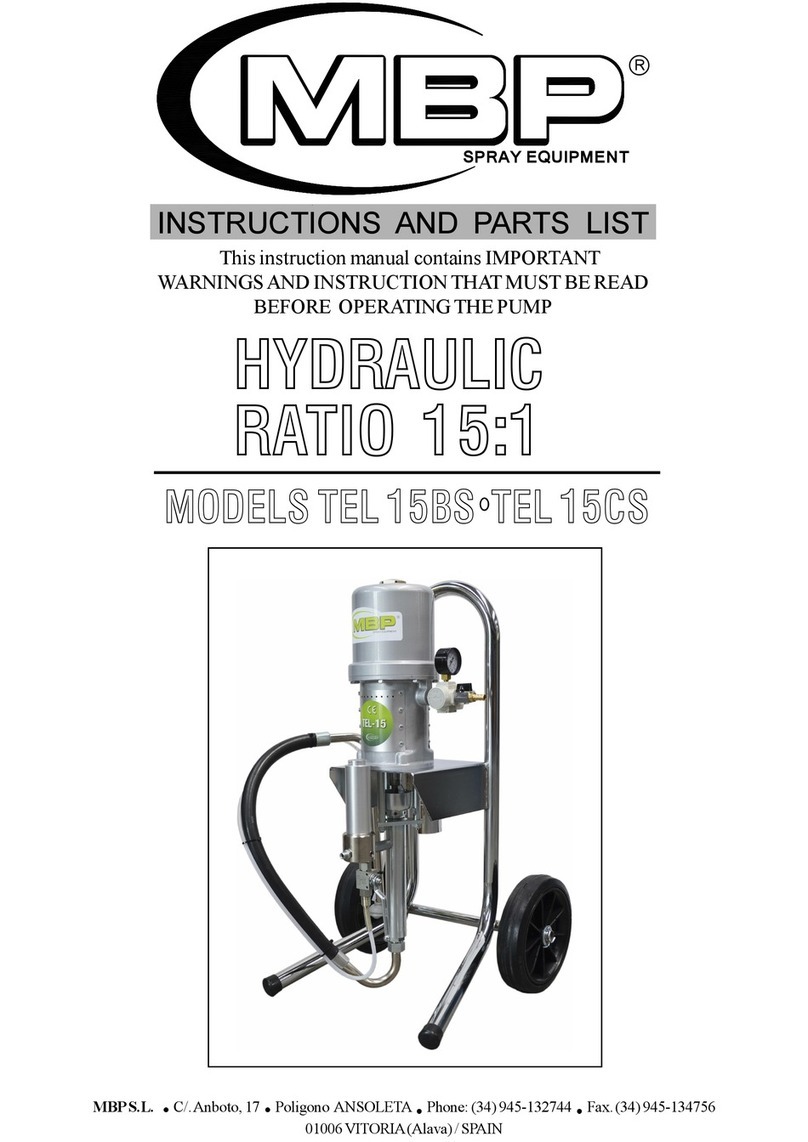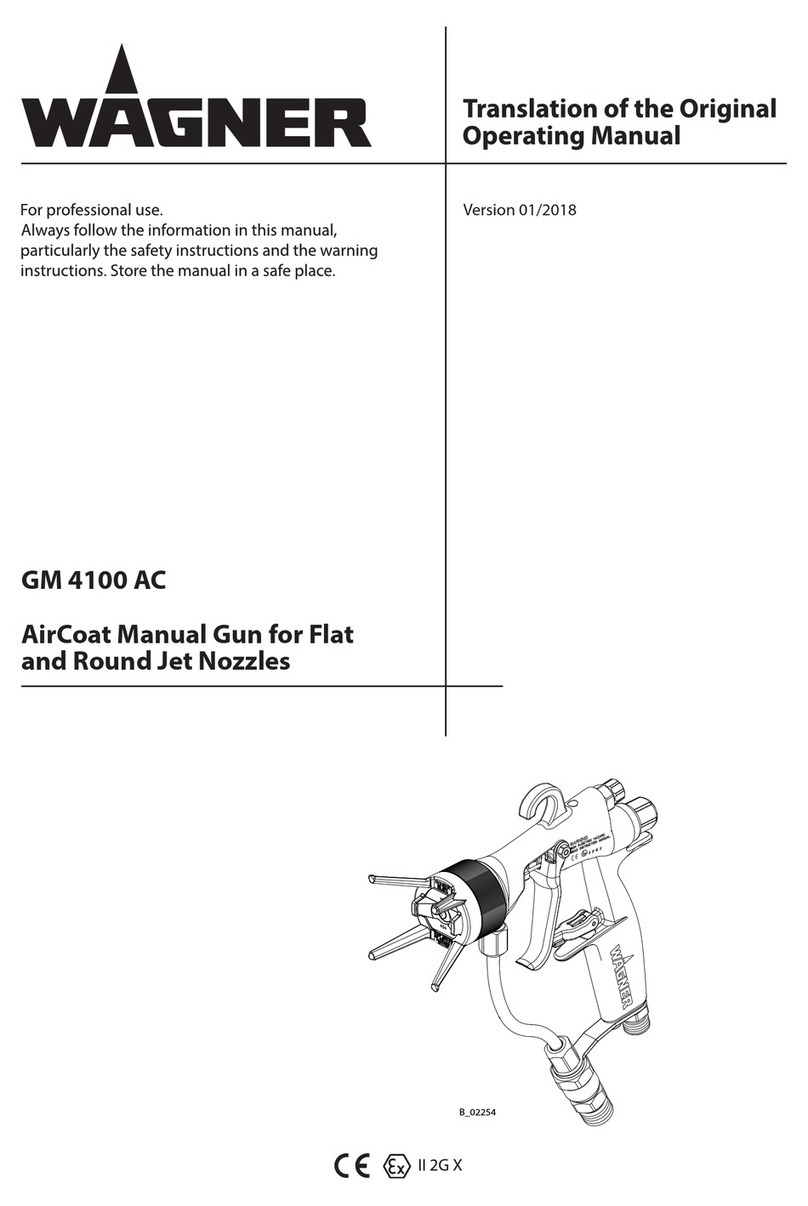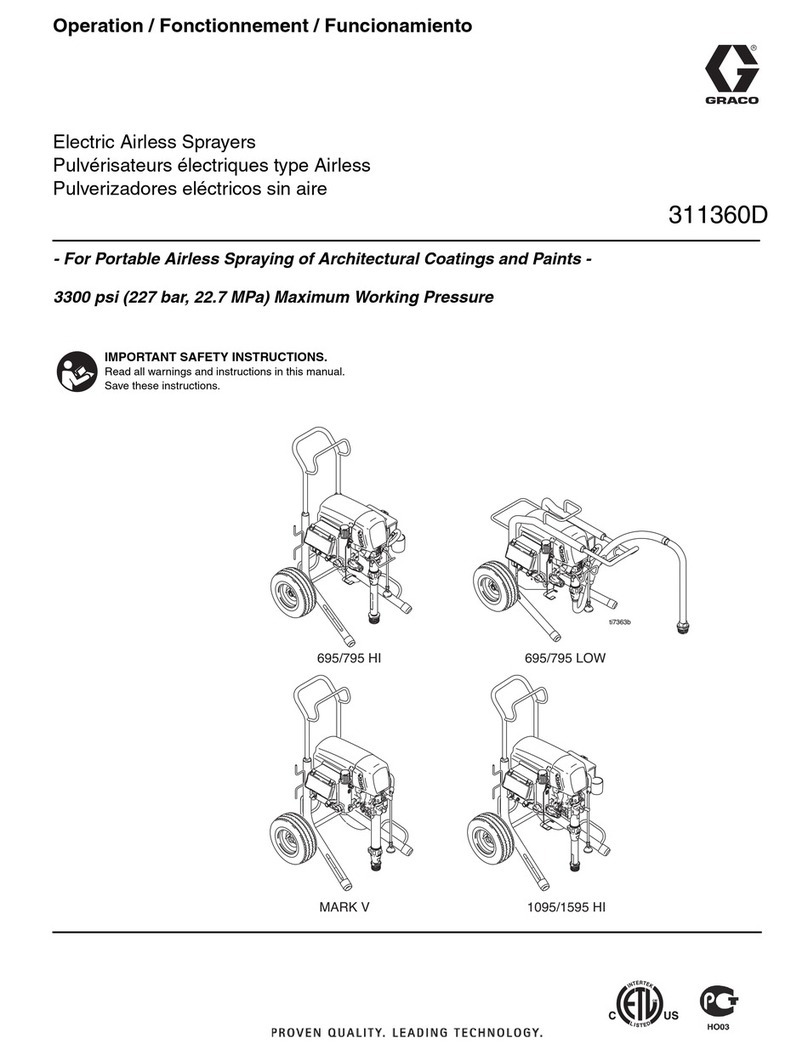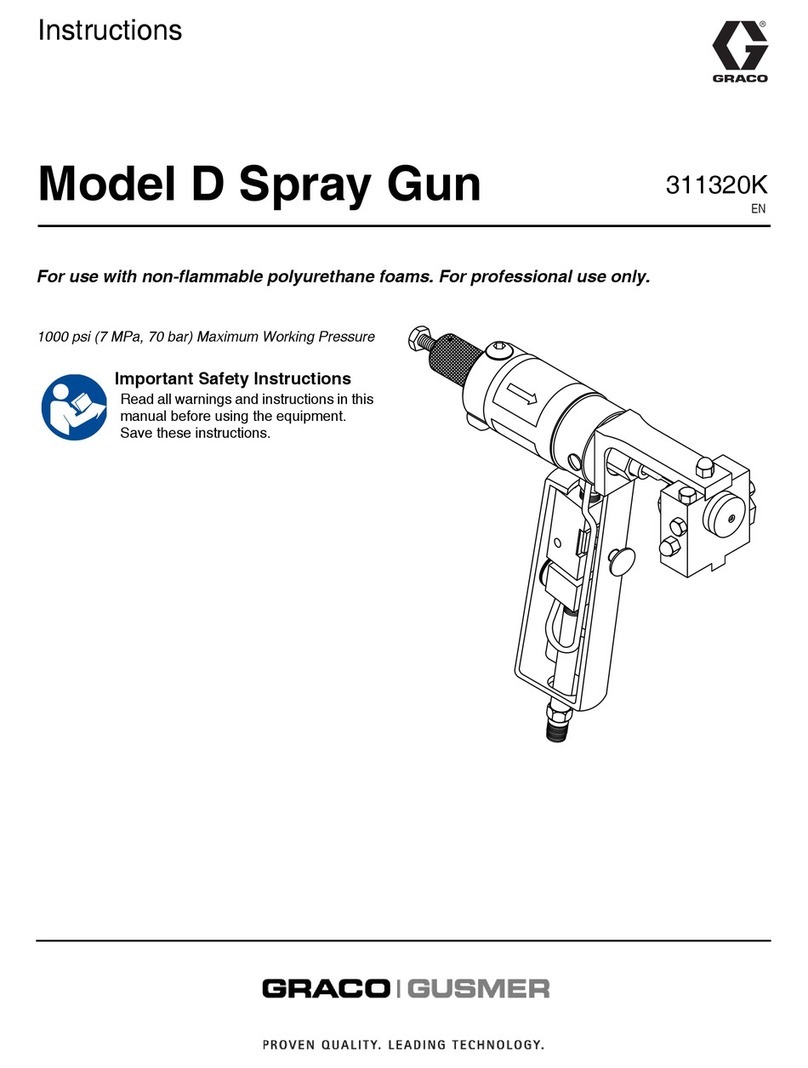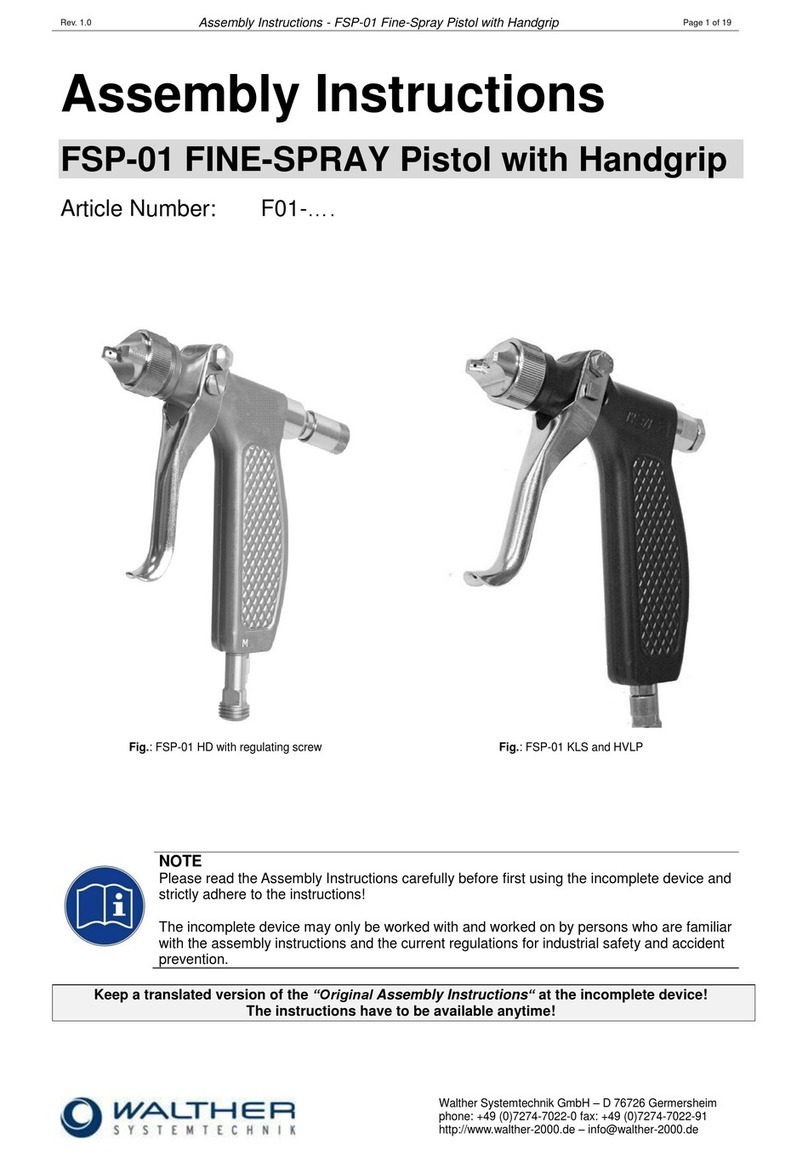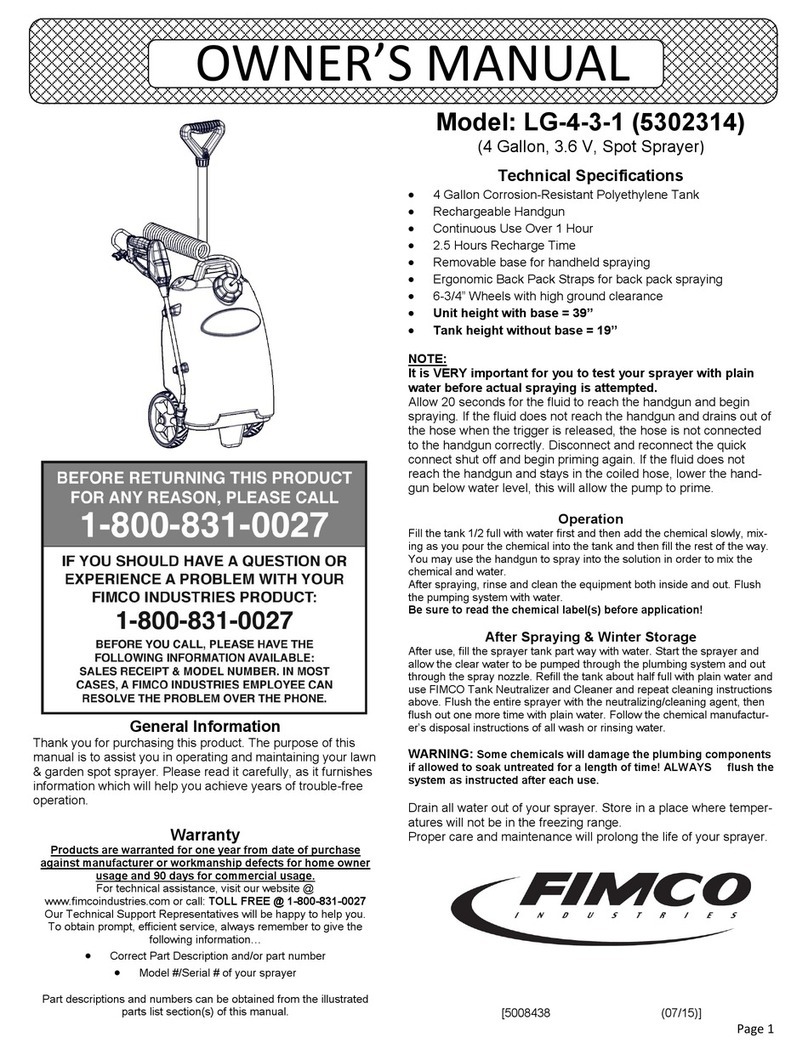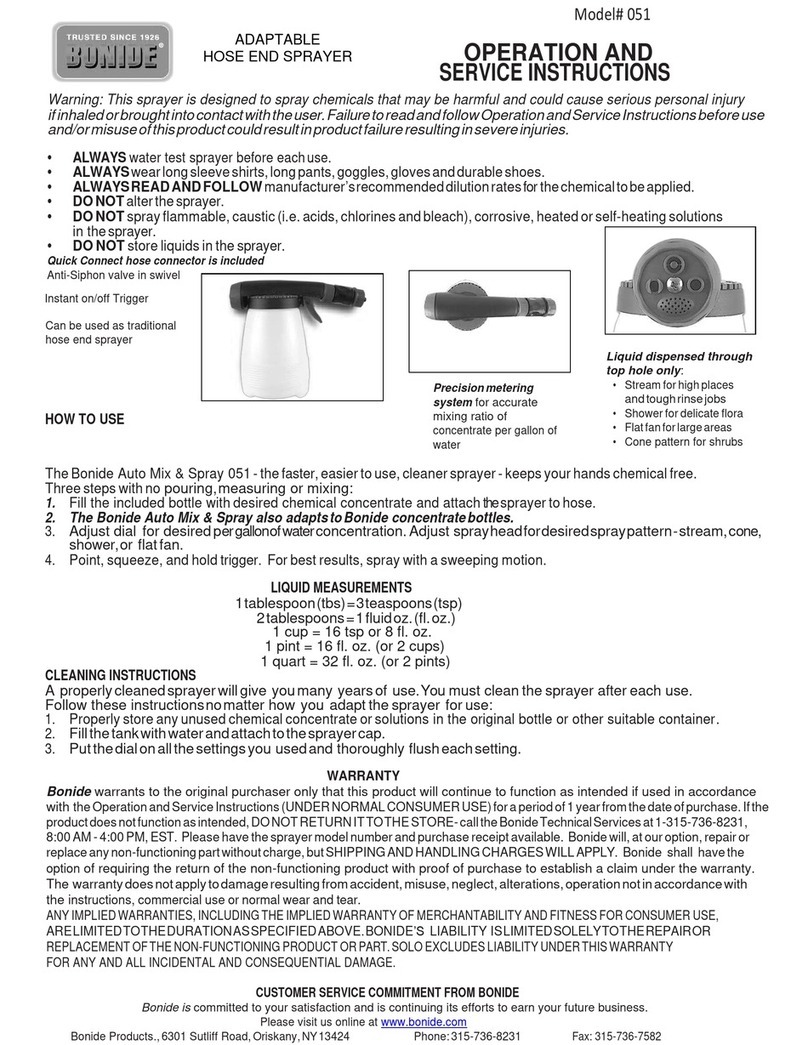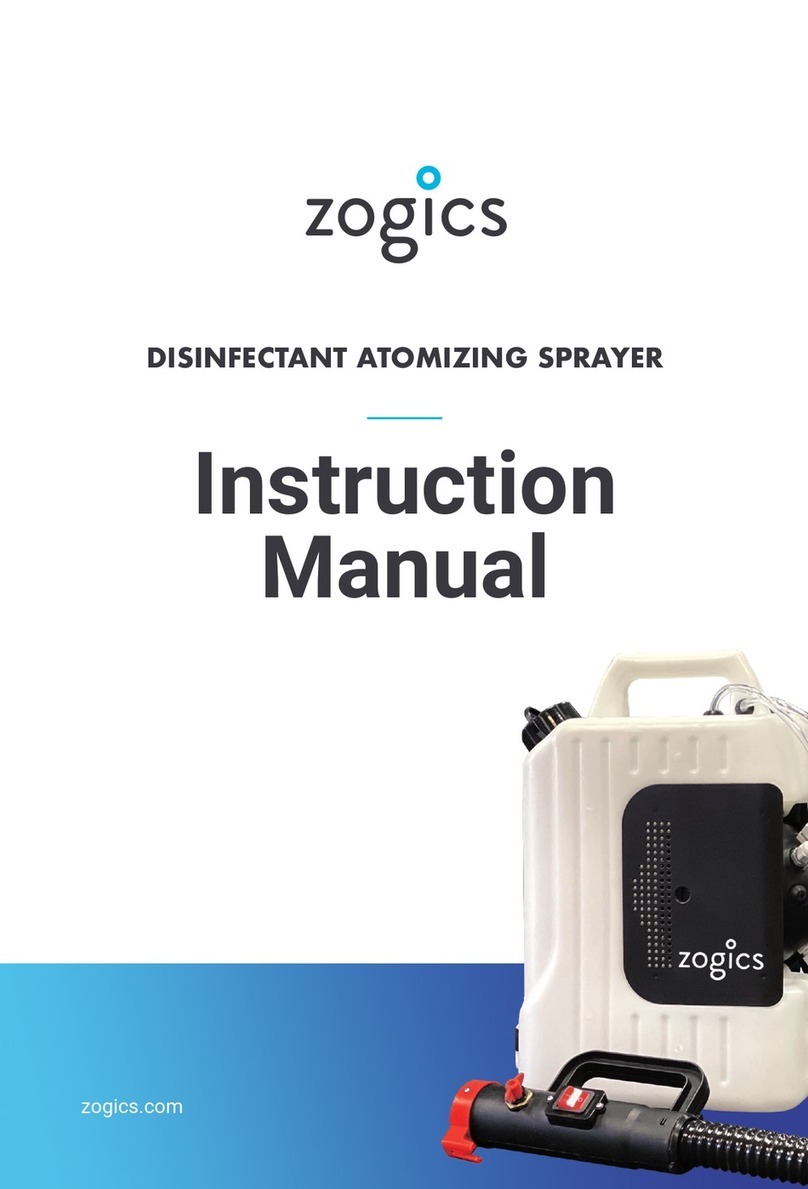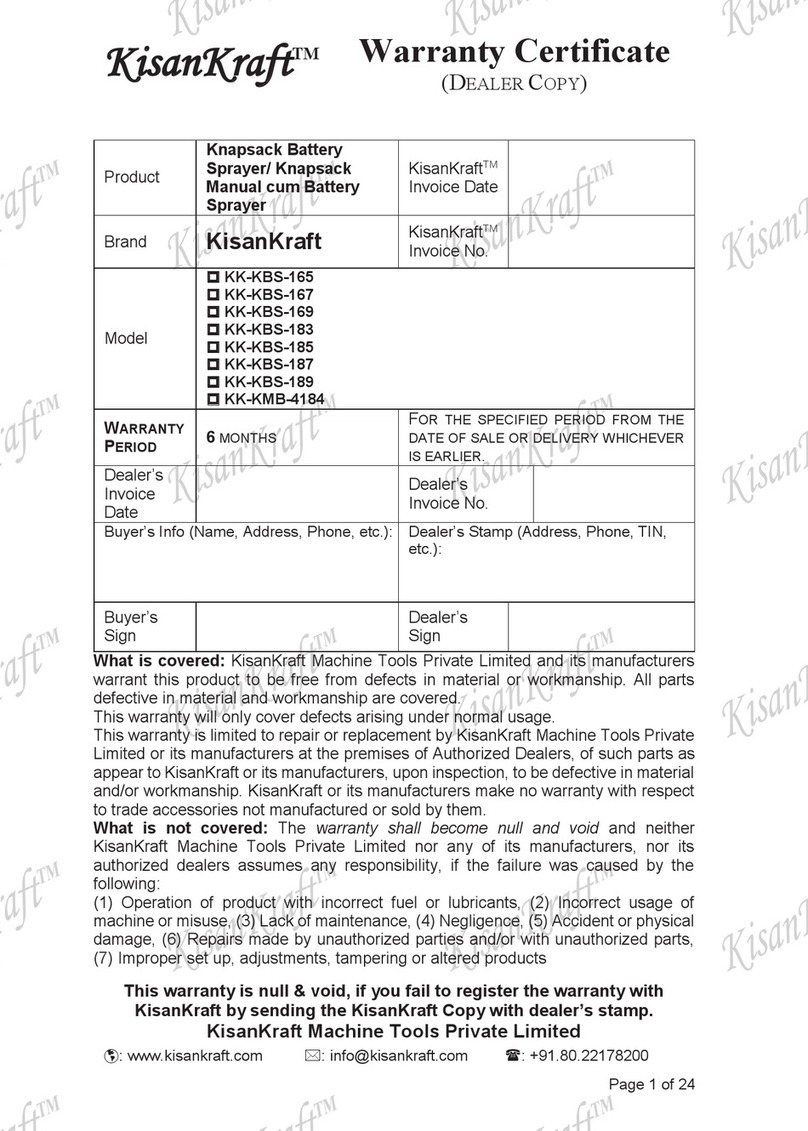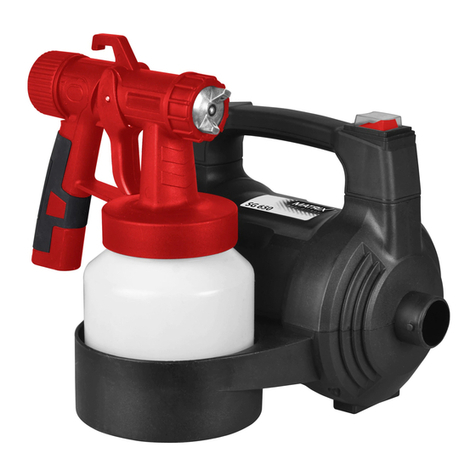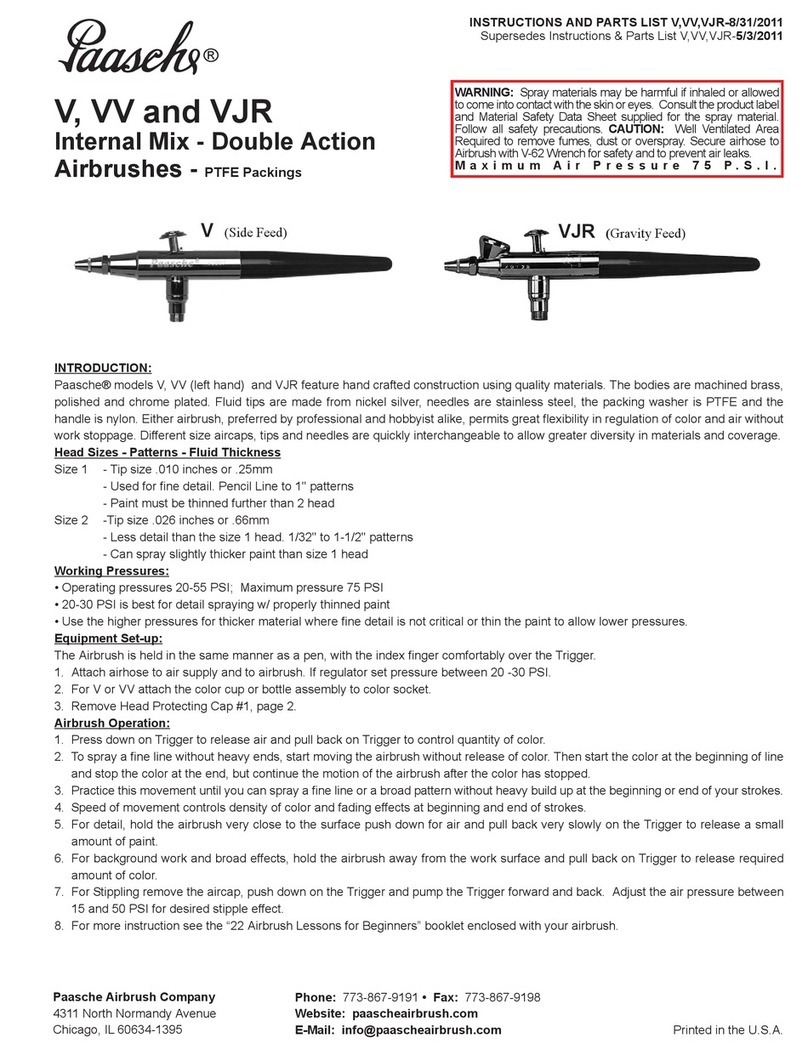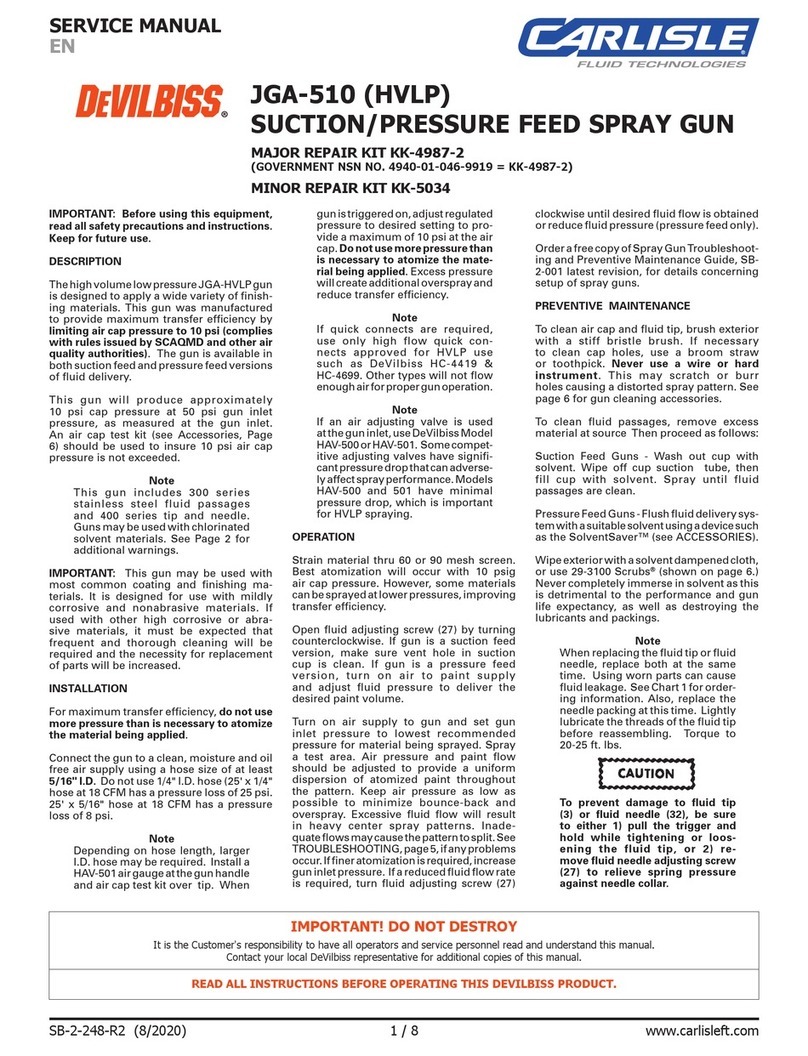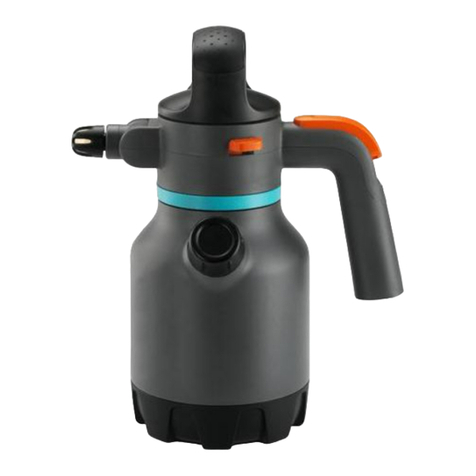NOCRY NPS-100 User manual

PAINT SPRAYER
INSTRUCTION MANUAL
We’ve tried to make this manual useful, simple, and understandable.
Please read it carefully, and keep it safe for future reference.


WHAT’S INSIDE THIS MANUAL
THE ABC’S OF PAINT SPRAYER SAFETY 2
Work area safety 4
Personal safety 5
Meaning of safety symbols on your paint sprayer 6
TECHNICAL SPECIFICATIONS 7
PACKAGE CONTENTS & THEIR PURPOSES 8
HOW TO USE YOUR PAINT SPRAYER 11
How to assemble your paint sprayer 11
How to switch the paint sprayer on/off 12
How to use the trigger 12
How to choose a suitable coating material 13
How to measure coating material thickness 13
How to thin coating material 14
How to strain coating material 15
How to set up the paint sprayer for spraying 15
How to adjust the paint sprayer 16
How to increase or decrease airflow (and why) 17
How to adjust paint volume (and why) 17
How to adjust the spray pattern (and why) 18
How to change the spray nozzles (and why) 20
How to change a sprayer nozzle 21
How to get the best results 22
How to take a break - the right way 23
How to transport your paint sprayer 23
How to clean the spray attachment 24
How to clean the main body of your paint sprayer 25
How to clean the air filter 26
How to clean the air ventilation hose 26
Some tips on troubleshooting 27
MAINTENANCE 29
PAINT SPRAYER LIABILITY 30
DISPOSAL 30
WARRANTY 31
HOW TO CONTACT NOCRY 32

2
THE ABC’S OF PAINT SPRAYER SAFETY
Read all safety warnings and instructions before using your paint
sprayer. They’re pretty reasonable, and neglecting them may bring a touch of
electric shock, fire, and/or serious injury to your paint spraying sessions. There
are other (and much better) ways to get your adrenaline going.
Save this manual for future reference, review in between uses, and make
sure that anyone who’s going to test your new paint sprayer has read and fully
understood all the information in here as well.
In case this manual happens to disappear, in the black hole all manuals
seem to go into, you can get a digital version of it at https://nocry.com/pages/
instructions, or by letting us know to [email protected].
So, let’s get to it, shall we?
vOnly use your paint sprayer and its accessories for spraying
paint onto inanimate objects. Would you use a screwdriver to
hammer a nail? Exactly.
v Never point the sprayer at yourself, other people or animals.
A glow-in-the-dark neon cat is a bad idea. Same goes for pointing the
sprayer at people. Paint in the eyes can cause damage to the sight, even
blindness - no joke.
v Do not to get too carried away and paint over important text
and information on containers, instruction manuals (like this one), or
the specifications given by the substance manufacturer.
vFollow the safety instructions of the materials, solvents, and
cleaning agents you use during preparation, during work, and when
cleaning your sprayer. Yes, more dull reading - important dull reading
nonetheless.
v Do not use any liquid of unknown hazard potential. It’s best to
stick to the standard paint bought in stores. No homemade concoctions.
v Keep your fingers, hands, limbs and any other body parts

3
away from the tip. If the sprayer can atomize paint, just imagine what
it could do to your fingers.
v Always properly cover any surface, object or area that you don’t
want covered in paint with thick protective, durable plastic sheeting.
v When spraying outdoors, take into consideration the wind
direction - your neighbor won’t thank you for their car’s new paint job.
It has happened.
v Do not lay your filled paint sprayer on its side as the paint inside
may spill, or clog the internal pipes.
vDo not use your paint sprayer if it doesn’t work as it should. Get
it repaired or replaced before using. Should you have any problems or
concerns about anything, anything at all (and we really mean it) let us
vBefore disassembling the spray attachment, open the container
to relieve the pressure. You can do that by simply unscrewing the
container.
vDo not abuse the cord. The cord isn’t the reason you’re having a bad
day - and it won’t be, if you don’t use it for carrying, pulling, or unplugging
thesprayer,andkeepitawayfromheat,oil,sharpedges,andmovingparts.
vAvoid bodily contact with earthed or grounded surfaces such
as pipes, radiators, stoves, and refrigerators.
vUnplug your paint sprayer before making any adjustments,
putting it in storage, or when the power supply is interrupted.
Seems reasonable, doesn’t it?
vMake sure there is nothing stuck in the moving parts of your
paint sprayer before turning it on. It moves fast. And it will ruin your
day even faster.
v To keep your paint sprayer well-maintained, regularly check if all
parts are working correctly. If you notice anything odd, definitely take
the sprayer for repair before using it.

4
v Work or repairs on the paint sprayer should only be carried out
by a professional. It’s best to leave the really serious stuff to a qualified
repair person who only uses original replacement parts.
vMake sure that anyone using your paint sprayer or servicing it
is acquainted with this manual. The exception to the rule are children
and infirm people - they shouldn’t be using your paint sprayer even if they
remember every word written here.
WORK AREA SAFETY
v Keep your work area clean and well illuminated. Accidents are
much more likely to happen in dirty, unorganized, or poorly lit workspaces
- accidents that are easily avoided with basic upkeep.
v When working in closed environment, ensure there is sufficient
ventilation to disperse any vapours from paint and/or solvents. Fun
fact: Those fumes are known to destroy brain cells, and extended
exposure can cause serious long term damage. An on-site extraction
system should be installed if you’re using the paint sprayer for
commercial purposes.
v Secure any movable workpiece(s) you’re working on. A workpiece
secured with suitable clamps or in a vice is much more likely to be steady
and stay in place than one held by hand.
v Do not operate your power tools in dusty or explosive areas, such
as in the presence of flammable liquids or gases, for a very simple reason
- power tools may create sparks which could ignite the dust or fumes.
v When working outside, use an extension cord meant specifically
for outdoor use, and of an appropriate length. It’s going to be
much more convenient, and will reduce the risk of an electric shock.
v Your paint sprayer is not waterproof or splash proof. Do not use
it in the rain, splash with water, immerse in liquid, or use as a water gun
It’s an electric tool after all.

5
v If damp conditions are unavoidable, use a residual current device
(RCD) protected supply.
v Keep children and bystanders away. Distractions can cause you to
easily lose control, so consider operating your power tools a solo venture.
You’ll catch up with everyone later, when you’ve made progress with your
project.
vIf you absolutely must have children in the working area, ensure
that they’re always closely supervised by another,
responsible, adult, and do not interfere with your work.
vFamiliarize yourself with your local general rules of
occupational health and safety. The sooner you do that, the sooner
you can start using your paint sprayer.
PERSONAL SAFETY
vEye, ear and respiratory protection is a must when operating your
paint sprayer. Do not underestimate the power of personal safety
equipment.
vCommon sense is the best protection, isn’t it? Stay alert - watch
what you’re doing, exercise common sense, and do not operate power
tools when you’re tired or under the influence of drugs, alcohol, or
strong medication.
vDo not take unnecessary risks by trying to reach areas
that are obviously too far away to reach safely. Keep properfooting
and balance at all times - it’ll help you keep control in unexpected
circumstances, whether it be the power tool slipping out of your hands,
or someone deciding it would be fun to attempt to pull a jumpscare on
you in your workshop.
NB! NoCry Work & Safety Gear and the manufacturer shall not be liable for any
changes made to the tool, nor for any damage resulting from such changes.

6
MEANING OF SAFETY SYMBOLS
ON YOUR PAINT SPRAYER
These symbols are on your paint sprayer for a reason - to keep you aware and
safe. Please take them into account.
This paint sprayer conforms with health, safety and environmental
protection standards of the European Economic Area.
Read the instructions before starting to use this paint sprayer.
Wear safety goggles when using this paint sprayer.
Use respiratory protection when using this paint sprayer.
Use hearing protection when using this paint sprayer.
This paint sprayer is Class II (double insulated).
Do not discard of this paint sprayer together with household
waste - please refer to page 30 for tips on responsible disposal.

7
TECHNICAL SPECIFICATIONS
Model NoCry NPS-100 DINS Paint Sprayer
Voltage
220-240V,50Hz
Power consumption 600 W
Atomising output 200 W
Flow 1200 ml/min
Maximum viscosity 100 DIN/s
Pressure 22.1 kpai

8
Nozzle Sizes 1.5 mm, 1.8 mm, 2.2 mm and 2.6 mm
Container capacity 1000 ml
Cable length 2.02 m
Oscillation level 1.5 m/s2
Uncertainty K 1.5 m/s2
Total weight (main body
and spray attachment) 1.6 kg
PACKAGE CONTENTS & THEIR
PURPOSES
Repetition is the mother of all learning, so: Please remember to unplug your paint
sprayer before doing any work on it. That includes changing accessories, cleaning,
and servicing.
This is what you will find inside your paint sprayer package. If there’s anything
P.S. The images may not be to scale.

9
1 Paint sprayer main body
Houses the power motor that atomizes the
coating material inside the material container.
Learn how to assemble your paint sprayer on
page 11.
1 Spray attachment
Covers your project or wall with an even coat of
atomizedcoatingmaterialviathesprayernozzle.
Learn how to get the best results on page 22.
1 Material container (1000 ml)
Plastic container that holds material coating.
Attaches to the spray attachment, for details
see page 11.
1 Flow cup
Your tool for measuring the thickness (the
viscosity) of the coating material. This paint
sprayer will spray paint up to 100 DIN/s thick.
Pro tip: The flow cup also works great as a
pouring funnel.

10
4 Spray nozzles, Ø 1.5 mm, 1.8 mm, 2.2 mm,
and 2.6 mm
Each of the nozzles help you get a different fin-
ish on different materials - we’ve compiled a
little handy-dandy guide on page 20.
1 Cleaning pin
The secret to getting dried paint out of your
spray nozzle. We’d really recommend you thor-
oughly clean your paint sprayer after every use
- we’ve left some tips on how to best do it on
page 24.
1 Cleaning brush
Whereas the pin is for cleaning the spray noz-
zles, the brush is capable of reaching deep in-
side the inner tubes of your paint sprayer to
keep it clean and in working order. We’d really
recommend you to thoroughly clean your paint
sprayer after every use.

11
HOW TO USE YOUR PAINT SPRAYER
HOW TO ASSEMBLE YOUR PAINT
SPRAYER
Your paint sprayer has arrived disassembled, and will need to be put together
before use. Luckily, the process is relatively straight forward, and can be done in
no time at all - just make sure that your paint sprayer is NOT connected to the
power source before doing anything.
vFirstly, check that you have all the correct parts: a spray
attachment piece, a main body, and a material container. See page 8 to
see what they look like.
vBegin by attaching the spray attachment. Push the spray
attachment towards the main body (see below), and turn the spray
attachment lock to the locked position. Check that both are secure
before proceeding.

12
vNext, screw the container to the bottom of the spray attachment
and you are good to go!
HOW TO SWITCH THE PAINT
SPRAYER ON/OFF
Your paint sprayer doesn’t have an on/off switch as such. When the power cord is
plugged into the socket, your paint sprayer is on and ready to go. To turn the paint
sprayer off, pull the power cord out of the socket, aaaand... it’s off.
HOW TO USE THE TRIGGER
Once the paint sprayer is connected to a power source, gently hold down the
trigger to start the turbine motor. To start dispensing paint, press the trigger
further. That’s it.

13
HOW TO CHOOSE A SUITABLE
COATING MATERIAL
This paint sprayer is comfortable with the following list of coating materials:
v Colored paints
v Primers
v Solvent-based paints
v Anti-rust paints
v Water-soluble lacquer paints
v Glazes
v Impregnations
v Oils
v Textured paints
v Clear varnishes
v Synthetic enamels
v Alkyd resin varnishes
v Radiator paints
v Hammer effect enamels
v Mordants
v Special-effect paints
NB: Do not “feed” your paint sprayer facade paint, caustic solutions, acidic coating
substances, or any materials that contain highly abrasive components, or are
flammable. This paint sprayer will not work as a handheld flamethrower. Promise.
HOW TO MEASURE COATING
MATERIAL THICKNESS
Having the right material thickness is key to getting an even finish. Pay close
attention to the thickness (or viscosity) of your chosen coating material. Viscosity
is measured in DIN/s and can be found on the container of your coating material
-this paint sprayer can handle material thickness of up to 100 DIN/s.

14
You should check if your material is of the correct viscosity (before pouring it into
the material container) by performing the flow cup test.
To work out the DIN/s rating of your coating material:
HOW TO THIN COATING MATERIAL
If your chosen coating material took longer than 100 seconds to pass the flow cup
test, you will need to thin it using water or paint thinner.
To dilute your coating material:
v Pour into a fresh container.
v Add 1/2 a cup of water for every 3.8 litres of paint. (If using paint thinner,
add small amounts at a time, mix and check. A good ratio to use is 4:1
paint to thinner.)
v Slowly mix using a wooden stick or spoon.
Place your finger over the hole of the
included flow cup and fill it to the brim
with your chosen material. At the same
time, release your finger from the hole,
and start the timer. Stop the clock when
the flow cup has completely drained of
paint.
If you find that your coating material has
a viscosity rate of, or above, 100 DIN/s
(meaning it takes longer than 100 sec-
onds for material to pass through the
flow cup), then it is too thick and will
need to be thinned.

15
v Check the thickness again by doing the flow cup test. If the paint is
still too thick (over 100 DIN/s), dilute further by adding 1/8 of a cup of
water for every 3.8 litres of paint to be used. Mix and flow cup test
again, until you have a nice even material consistency.
Remember! Diluting painting material will change the color and lengthen drying
time. It will also mean spraying extra coats to achieve the desired finish.
Pro tip: If you find that your sprayer still seems to be unable to dispense material
as it should, try thinning the paint even more.
HOW TO STRAIN COATING MATERIAL
Once you have chosen your coating material, measured its viscosity and diluted it
(if needed), you are now ready to prepare the paint for spraying.
Before filling the material container, always strain your coating material. Straining
removes clumps that might otherwise clog the sprayer - making it easier to
maintain, and prolonging its life.
To strain, simply pour the prepared material through a paint strainer (or sieve,
pantyhose also work great), into a fresh container.
The coating material is now fully prepped, and you are now ready to set up your
paint sprayer for painting.
HOW TO SET UP THE PAINT
SPRAYER FOR SPRAYING
For best results, perform the following tasks before beginning any spray job…
v Detach the spray attachment from the main body of the paint
sprayer and set it aside. You can find the how-to back on page 11.

16
v Unscrew the container from the spray attachment, and pour
no more than 1000 ml of your prepared coating material into the
container. Flick back to page 11 to find out how.
v Align the suction tube. This is key to getting all the coating material
out of the container.
If painting objects that are on or
close to floor level , it’s best to po-
sition the suction tube
away
from the
body of the paint sprayer.
If spraying high up or overhead
objects and surfaces, such as a
ceiling, turn the suction tube
towards
the body of the paint sprayer.
v Reattach the filled material container with the suction tube aligned
to how you will be spraying to the spray attachment and reconnect it to
the paint sprayer’s main body - check page 11 for a short how-to.
HOW TO ADJUST THE PAINT SPRAYER
This paint sprayer is designed to deliver great results without you having to try
too hard. It uses a low pressure spraying technique that combines a high volume
of air with low air pressure (it’s called the HVLP - high volume, low pressure
system),
allowing for low paint mist formation, minimal fuss and mess. As opposed

17
to conventional application of coating a surface, you have full control over both the
volume of material and the volume of air you use.
This reduces the amount of paint required to cover an object or surface, making
this method highly economical and ensures consistent surface quality and cover.
As you can see, your paint sprayer takes care of things by itself.
This paint sprayer has a number of adjustment options when it comes to spraying.
We highly recommend you try out different adjustment combinations
until you find what works best for your project.
HOW TO INCREASE OR
DECREASE AIRFLOW (AND WHY)
Your paint sprayer has two airflow modes: Maximum and minimum. Increasing or
decreasing the amount of airflow changes the amount of pressurized air coming
from the sprayer’s motor.
For thicker paints (more than 50
DIN/s) - turn the dial clockwise to
maximum for when you need to quickly
cover a large area.
For thinner paints (less than 50
DIN/s) - turn the dial anti-clockwise
to minimum for when you need a more
steady, deliberate spray.

18
HOW TO ADJUST PAINT
VOLUME (AND WHY)
The paint volume adjustment dial is located behind the sprayer’s trigger. Setting
the dial to a fixed position means the trigger can only be pulled back a certain
amount. The tighter the dial, t he further back you can pull the trigger, allowing
more material to pass through the nozzle tip, increasing the amount of paint
dispensed.
For thicker paints (more than 50
DIN/s) - turn the dial clockwise (tight
against the trigger) to increase the
amount of paint dispersed by the
sprayer.
For thinner paints (less than 50
DIN/s) - turn the dial anti-clockwise
(loose against the trigger) to de-
crease the amount of paint dispersed
by the sprayer.
To get the fine mist that works for you, experiment with the dial while spraying on
cardboard or other piece of scrap material until you find the right position.
HOW TO ADJUST THE
SPRAY PATTERN (AND WHY)
Use the spray adjustment lever at the front of the paint sprayer to change the
spray pattern size. You can either widen or focus the spray pattern in three fixed
positions - vertical, horizontal or circular.
Other manuals for NPS-100
2
This manual suits for next models
1
Table of contents
Other NOCRY Paint Sprayer manuals



